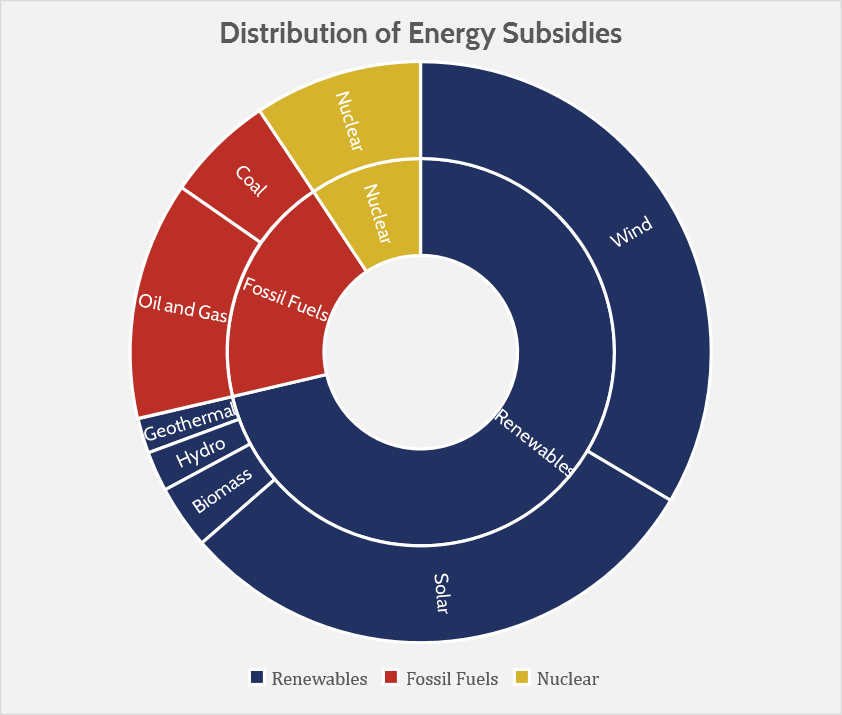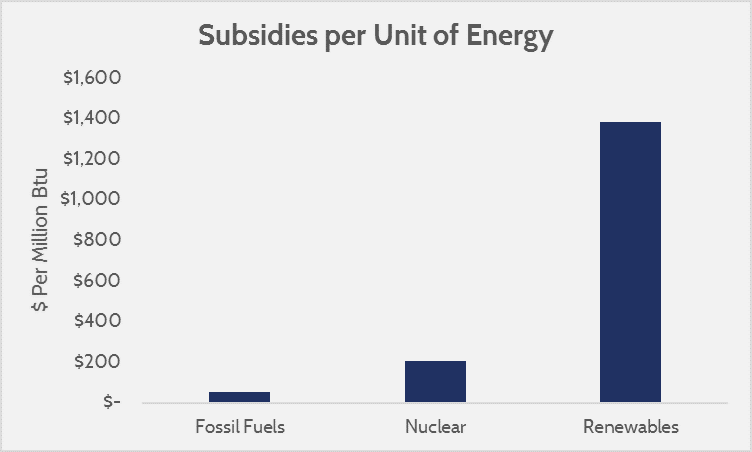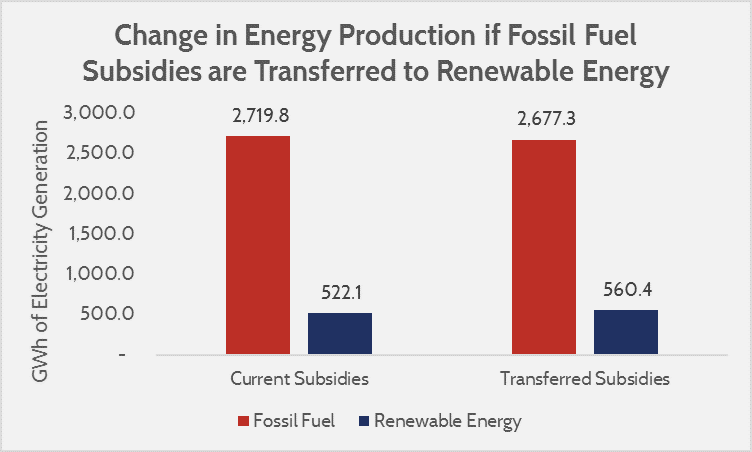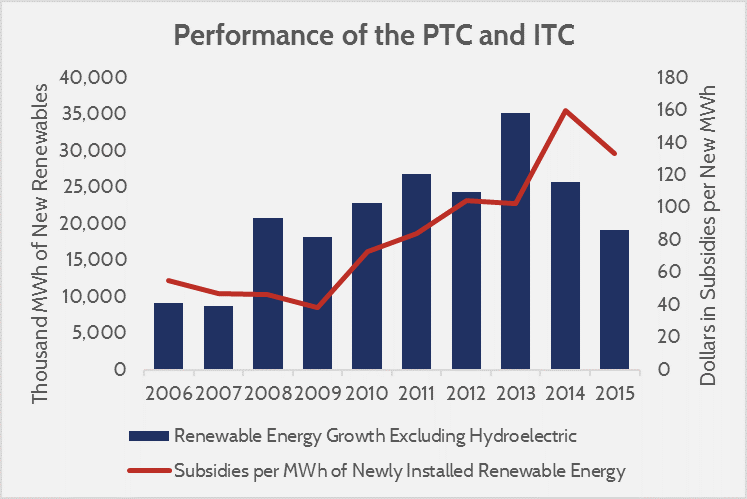Research
August 4, 2016
How Much Would Ending Fossil Fuel Subsidies Help Renewable Energy?
- A recent policy platform has called for an end to fossil fuel subsidies and extension of renewable energy subsidies, but ignores the reality that renewable energy already claims 43 percent of energy subsidies compared to 11 percent for fossil fuel.
- Estimates of the magnitude of fossil fuel subsidies can be misleading, since they may include the estimated costs of non-budgetary externalities or non-energy specific subsidies that cannot be eliminated within energy policy.
- If energy subsidies are given, they should be awarded based on policy goals, not simply given to specific energy sources; the market is far better at picking winners and losers than politicians.
Introduction
The Democratic Party has released its policy platform, and included some key energy policy objectives. One objective is to “eliminate fossil fuel subsidies,” while “defending and extending subsidies for renewable energy.” It is often politically expedient to talk about fossil fuel subsidies as a barrier to the development of renewable energy, but the reality is that fossil fuels take just 11 percent of energy subsidies. The idea that cutting these subsidies would be a game changer for clean energy is not supported by any data.
How Large Are Fossil Fuel Subsidies?
Estimates of fossil fuel subsidies are often misleading because they include costs beyond actual government spending on energy. For example, the International Monetary Fund (IMF) states that the U.S. “subsidizes” fossil fuel companies by $699 billion annually—even bigger than the defense budget. However, of this $699 billion estimate, only $13 billion are traditional budget subsidies. The vast majority, $640 billion, is the IMF estimate of the social cost of externalities (pollution, etc.). Failure to eliminate putative externalities is vastly different from government spending to reduce a market price. Further, $45 billion of the IMF’s estimate is from “untaxed” fossil fuels, which is inaccurate because the U.S. uses income taxes, not consumption taxes (as the IMF prefers). In short, there is an enormous gulf between $699 billion and the $13 billion of traditional subsidies.
Other estimates are more reasonable at $17.2 billion in a single year, but these are problematic as well. Such estimates include all subsidies that a fossil fuel company can claim, including subsidies that are available to any company (expensing, credits for taxes paid overseas, etc.). Ending those subsidies would affect more than just energy companies, and require comprehensive tax reform.
So how much does the U.S. government actually spend on fossil fuel subsidies? The Energy Information Administration (EIA) claims this figure is $3.4 billion—less than one percent of the IMF’s estimate.
Fossil Fuels and the Reality of Energy Subsidies
The EIA’s assessment of energy subsidies found that in FY 2013 the U.S. government spent $29.2 billion on energy subsidies. Of this, about $3.4 billion (11 percent) went to fossil fuels, $12.6 billion went to renewable energy (43 percent), $1.6 billion went to nuclear power (5 percent), and the rest went to conservation and low-income assistance. Solar and wind power took the lion’s share of subsidies, amounting to 64 percent of all electricity production subsidies, far exceeding other forms of energy in both direct subsidies and tax credits. The chart below illustrates the distribution of subsidies by energy type.

Source: Energy Information Administration
When applying the EIA’s subsidies data to energy production, we get a better idea of how fossil fuels are subsidized compared to renewable energy. The graph below shows subsidies per million British thermal units of energy production.

Source: Energy Information Administration
Renewable energy is subsidized on a larger scale than fossil fuels. In fact, per unit of energy, renewable subsidies are 25 times greater than fossil fuels, and 7 times greater than nuclear power.
How Much Renewable Energy Would be generated by eliminating fossil fuel subsidies?
Even though fossil fuels are not subsidized on the order of hundreds of billions of dollars like the IMF claims, $3.4 billion is a significant amount of money. This begs the question of how much renewable energy would be generated by eliminating those subsidies. Assessing such a question is speculative, because a portion of subsidies are typically focused on capital investment or research and development, yielding benefits years later. For the purpose of comparison though, we can assume a direct subsidy to fund electricity generation.
Applying the EIA’s projections of levelized costs of electricity (LCOE) to coal and natural gas show that $3.4 billion could fund 42.5 GWh of electricity. If we then take that amount and distribute it among renewable energy sources at the same proportion as existing subsidies, it would produce 38.2 GWh of renewable electricity. The total change would be a 1.6 percent decline in fossil fuel use, and a 7 percent increase in renewable energy use. The mix of electricity generation would go from 62.2 percent fossil fuel and 12 percent renewable energy, to 61.3 percent fossil fuel and 12.8 percent renewable energy. This also leaves a 4.3 GWh shortfall, which would cost roughly $317 million to service with either natural gas or wind—but the capacity required is only 0.55 MW (natural gas). The likely market response would be to slightly raise prices to offset reduced supply, resulting in the opposite of the desired effect of a subsidy.

Source: Energy Information Administration and AAF Estimates
Although from a budget perspective $3.4 billion is a fair amount of money, as an energy subsidy it makes very little difference. Market conditions play a bigger role in determining market penetration among energy types than subsidies.
Naturally, this also leads to the question of how effective renewable energy subsidies are. “Extend and defend” is a reference to the Production Tax Credit and Investment Tax Credit (PTC and ITC), which are subsidies designed to increase growth of renewable energy (with a particular preference to wind and solar) by accelerating the ability to take advantage of economies of scale. This form of subsidy is more effective early in the life of a new technology, and tends to become less effective over time. For this reason, the PTC and ITC were assigned an expiration date—but Congress has extended this each time it nears.
Source: Energy Information Administration, and Internal Revenue Service
The graph above shows new energy generation eligible to claim the PTC or ITC (in blue), and the relative amount of subsidies for new energy generation (in red). Over time, the PTC and ITC have risen in costs, but the costs have grown faster than the rate of energy growth. This means that the subsidy effectiveness is diminishing, and it is costing more to get less.
The PTC and ITC also have a history of cost overruns. In 2007, the projected cost of the PTC from 2008-2012 was $5.5 billion. The actual cost was 24 percent higher, at $6.8 billion. In 2011 the projected 2012-2016 cost was $13.9 billion, and the actual cost is 17 percent higher at $16.3 billion. This year, the PTC and ITC are expected to cost $860 million more than last year.
The most recent renewal of the PTC and ITC even omitted fuel cell technology, further transitioning the credits into an inefficient subsidy vehicle for only a few forms of energy. The subsidies have been drifting further from their initial purpose of accelerating the entry of new technology to the market, now serving a political preference over a policy goal.
If policymakers want to increase the amount of clean energy powering America (a major goal of the Democratic Party’s policy platform), then ending fossil fuel subsidies can help put renewable energy in a better market position. However, the market—not subsidies—will be the most important factor in renewable energy growth, and increasingly ineffective renewable energy subsidies should not be excused from scrutiny.
The Policy Lowdown
Energy subsidies cover a wide array of technologies, and target different policy issues. This includes research and development for safer nuclear power, environmental concerns, low-income assistance, and others. However, subsidies are not the most efficient tools for achieving energy policy goals.
A better solution than ending one energy source’s subsidies and extending another’s would be to eliminate preferential treatment among existing subsidies, and award them based on policy goals. This would allow the market to find the most efficient way to achieve that policy goal. Additionally, eliminating subsidies and implementing pricing mechanisms to drive the market away from undesired behavior can be an even better solution.
Given the high cost of energy subsidies, it is reasonable to consider reforming or ending some, but all energy subsidies should be reviewed—not just fossil fuel subsidies. Ultimately, the process of reforming energy subsidies should be focused on goals as well as methods, and supported by data analysis.











